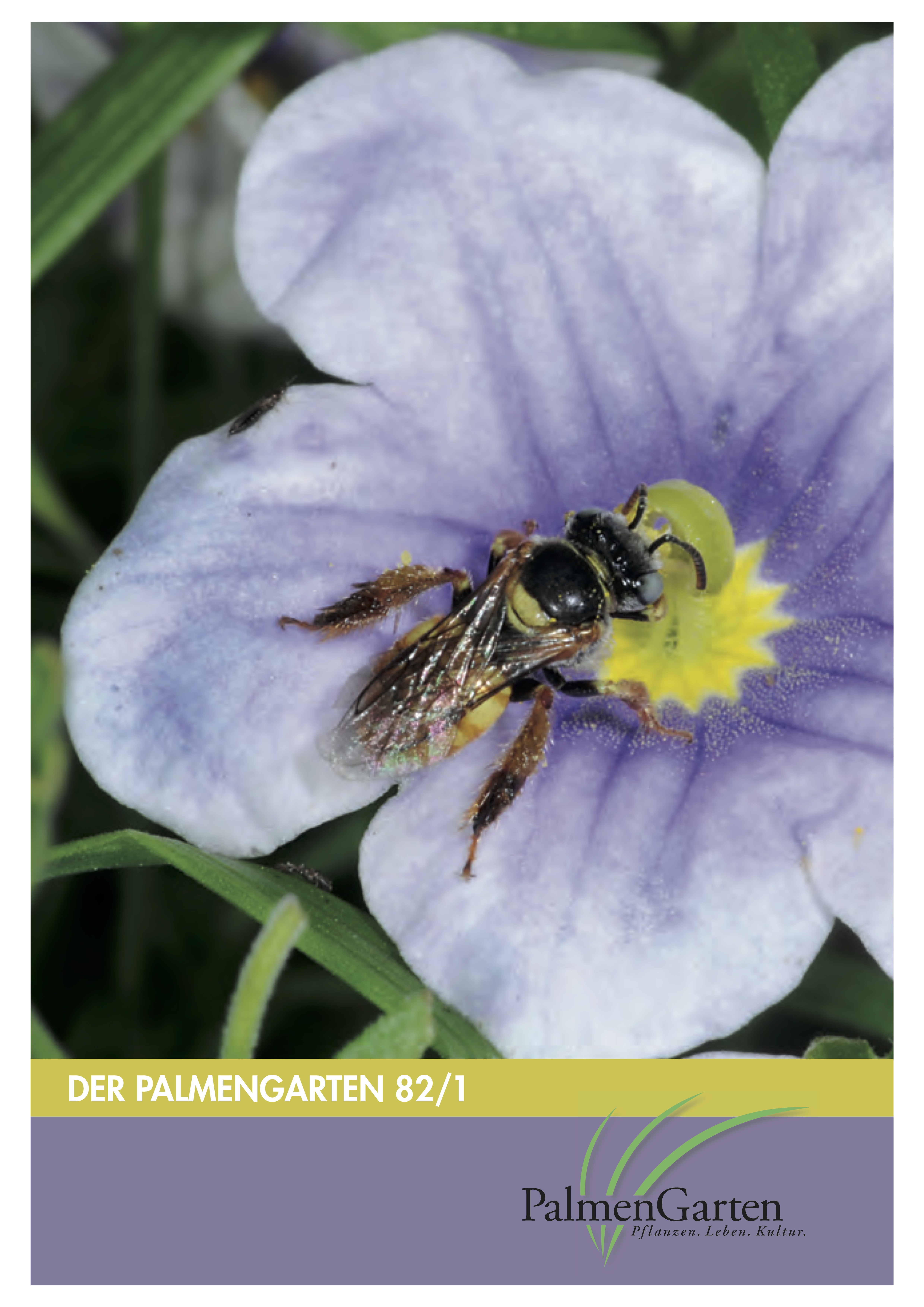Die großen wissenschaftlichen Leistungen von Stefan Vogel (1925–2015) Teil 5a. Öl statt Nektar – die Ölblumen (Allgemeine Aspekte)
DOI:
https://doi.org/10.21248/palmengarten.461Abstract
Nach der Entdeckung der Parfümblumen hat Stefan Vogel einen weiteren neuen Blumentypus erkannt und erforscht: die Ölblumen. Hier wird von den Blüten fettes Öl als Sammelgut angeboten, das in den sogenannten Elaiophoren gebildet wird. Das Öl wird von spezialisierten Bienen (Vertreter mehrerer Gruppen der Apidae-Apinae und zwei Gattungen der Melittidae-Melittinae) mit hochdifferenzierten Sammelstrukturen an den Beinen oder am Hinterleib gesammelt, und, mit Pollen vermischt, als Futter für die Brut verwendet. In reiner Form wird es auch zum Imprägnieren der Brutzellen genutzt. In über 20, teils sehr umfangreichen Publikationen hat Vogel Ölblumen in 10 Familien meist tropisch- und subtropischer Verbreitung nachgewiesen, beschrieben und den Bestäubungsmodus aufgeklärt (eine weitere Familie bzw. Gattung wurde von Simpson & Neff 1981 hinzugefügt). In diesem Beitrag werden allgemeine Aspekte der Ölblumen (Entdeckungs- und Erforschungsgeschichte, Vorkommen bei den Angiospermen, Grundtypen von Elaiophoren, Nutzung des Öls, Öl-Chemie, Überblick über ölsammelnde Bienen), dargelegt. In der nächsten Ausgabe dieser Zeitschrift wird eine Auswahl von Ölblumen näher beschrieben und illustriert.
Literaturhinweise
Aguiar, A. J. C. & Melo, G. A. R. 2009: Notes on oil sources for the bee genus Caenonomada (Hymenoptera, Apidae, Tapinotaspidini). – Revista Brasil. Entomol. 53: 154–156. https://doi.org/10.1590/s0085-56262009000100033
Aguiar, A. J. C. & Melo, G. A. R. 2011: Revision and phylogeny of the bee genus Paratetrapedia Moure, with description of a new genus from the Andean Cordillera (Hymenoptera, Apidae, Tapinotaspidini). – Zool. J. Linn. Soc. 162: 351–442. https://doi.org/10.1111/j.1096-3642.2010.00678.x
Buchmann, S. L. 1987: The ecology of oil flowers and their bees. – Ann. Rev. Ecol. Syst. 18: 343–369. https://doi.org/10.1146/annurev.es.18.110187.002015
Buchmann, S. L. & Buchmann, M. D. 1981: Anthecology of Mouriri myrtilloides (Melastomataceae, Memecylae), an oil flower in Panama. – Biotropica 13: 7–24. https://doi.org/10.2307/2388066
Cane, J. H., Eickwort, G. C., Wesley, F. R. & Spielholz, J. 1983: Foraging, grooming, and mating behaviors of Macropis nuda (Hymenoptera: Melittidae) and use of Lysimachia ciliata (Primulaceae) oils in larval provisions and cell lining. – Amer. Midl. Nat. 110: 257–264. https://doi.org/10.2307/2425267
Cocucci, A. A. 1991: Pollination biology of Nierembergia (Solanaceae). – Plant Syst. Evol. 174: 17–35. https://doi.org/10.1007/bf00937691
Danforth, B. N., Cardinal, S., Praz, C., Almeida, E. A. B. & Michez, D. 2013: The impact of molecular data on our understanding of bee phylogeny and evolution. – Ann. Rev. Entomol. 58: 57–78. https://doi.org/10.1146/annurev-ento-120811-153633
Goldblatt, P., Manning, J. C. & Rudall, P. 1998: Iridaceae. – In: Kubitzki, K. (ed.): The families and genera of vascular plants. III. Monocotyledons, Lilianae (except Orchidaceae). – Berlin.
Houston, T. P., Lamont, B. B., Radford, S. & Errington, S. G. 1993: Apparent mutualism between Verticordia nitens and V. aurea (Myrtaceae) and their oil-ingesting bee pollinators (Hymenoptera: Colletidae). – Austral. J. Bot. 41: 369–380. https://doi.org/10.1071/bt9930369
Kiew, R., Weber, A. & Burtt, B. L. 1998: Three new genera of Gesneriaceae from limestone of Peninsular Malaysia. – Beitr. Biol. Pflanzen 70: 383–403.
Kuhlmann, M. 2014: Nest architecture and use of floral oil in the oil-collecting South African solitary bee Rediviva intermixta (Cockerell) (Hymenoptera: Apoidea: Melittidae). – J. Nat. Hist. 48: 2633–2644. https://doi.org/10.1080/00222933.2014.909069
Kuhlmann, M. & Hollens, H., 2014: Morphology of oil-collecting pilosity of female Rediviva bees (Hymenoptera: Apoidea: Melittidae) reflects host plant use. – J. Nat. Hist. 49: 561–573. https://doi.org/10.1080/00222933.2014.939732
Manning, J. & Goldblatt, P. 2002: The pollination of Tritoniopsis parviflora (Iridaceae) by the oil-collecting bee Rediviva gigas (Hymenoptera: Melittidae): the first record of oil-secretion in African Iridaceae. – South African J. Bot. 68: 171–176. https://doi.org/10.1016/s0254-6299(15)30416-6
Martins, A. C., Melo, G. A. R. & Renner, S. S., 2014: The corbiculate bees arose from New World oil-collecting bees: Implications for the origin of pollen baskets. – Mol. Phylogenet. Evol. 80: 88–94. https://doi.org/10.1016/j.ympev.2014.07.003
Melo, G. A. R. & Aguiar, A. J. C. 2008: New species of Tapinotaspoides (Hymenoptera, Apidae, Tapinotaspidini). – Zootaxa 1749: 53–61. https://doi.org/10.11646/zootaxa.1749.1.5
Michez, D. & Patiny, S. 2005: World revision of the oil-collecting bee genus Macropis Panzer 1809 (Hymenoptera: Apoidea: Melittidae) with a description of a new species from Laos. – Ann. Soc. Entomol. Fr. 41: 15–28. https://doi.org/10.1080/00379271.2005.10697439
Michez, D., Patiny, S. & Danforth, B. N. 2009: Phylogeny of the bee family Melittidae (Hymenoptera: Anthophila) based on combined molecular and morphological data. – Syst. Entomol. 34: 574–597. https://doi.org/10.1111/j.1365-3113.2009.00479.x
Possobom, C. C. F. & Machado, S. R. 2017: Elaiophores: Their taxonomic distribution, morphology and functions. – Acta Bot. Brasil. 31: 503–524. https://doi.org/10.1590/0102-33062017abb0088
Rasmussen, C. & Olesen, J. M. 2000: Oil flowers and oil-collecting bees. – Norske Videnskap.-Akad., I. Mat. Naturvidenskap. Kl., Skrift., Ny Serie 39: 23–31. https://doi.org/10.1590/0102-33062017abb0088
Renner, S. S. & Schaefer, H. 2010. The evolution and loss of oil-offering flowers – new insights from dated phylogenies for angiosperms and bees. – Phil. Trans. Roy. Soc. London, B, 365: 423–435. https://doi.org/10.1098/rstb.2009.0229
Roig Alsina, A., 1999: Revision of the oil-collecting bees of the genus Chalepogenus Holmberg (Hymenoptera, Apidae, Tapinotaspidini). – Rev. Mus. Argentino Cienc. Nat., Nueva Serie 1: 67–101. https://doi.org/10.22179/revmacn.1.143
Roig Alsina, A: 2003: A revision of the bee genus Tapinotaspis Holmberg (Hymenoptera: Apidae, Tapinotaspidini). – Mitt. Münch. Entomol. Ges. 93:45–53.
Schaefer, H. & Renner, S. S. 2008: A phylogeny of the oil bee tribe Ctenoplectrini (Hymenoptera: Anthophila) based on mitochondrial and nuclear data: evidence for Early Eocene divergence and repeated out-of-Africa dispersal. – Mol. Phylogenet. Evol. 47: 799–811. https://doi.org/10.1016/j.ympev.2008.01.030
Schaefer, H., Bartholomew, B. & Boufford, D. E. 2012: Indofevillea jiroi (Cucurbitaceae), a new floral oil producing species from northeastern Myanmar. – Harvard Papers Bot. 17: 323–332. https://doi.org/10.3100/025.017.0213
Schäffler, I. & Dötterl, S. 2011: A day in the life of an oil bee: Phenology, nesting & foraging behaviour. – Apidologie 42: 409–424. https://doi.org/10.1007/s13592-011-0010-3
Schäffler, I., Steiner, K. E., Haid, M., van Berkel, S. S., Gerlach, G., Johnson, S. D., Wessjohann, L. & Dötterl, S. (2015): Diacetin, a reliable cue and private communication channel in a specialized pollination system. – Scientific Reports 5: 1-11; Art. no. 12779. https://doi.org/10.1038/srep12779
Seipold, L. 2004: Blütenöle – Chemische Analyse, Biosynthese und Betrachtungen zur Entstehung von Ölblumen. – Diss. Univ. Halle-Wittenberg.
Sérsic, A. N. 2004: Pollination in the genus Calceolaria. – Stapfia 82[fett]: 1-121.
Simpson, B. B. & Neff, J. L. 1981: Floral rewards: alternatives to pollen and nectar. – Ann. Missouri Bot. Gard. 68: 301–322. https://doi.org/10.2307/2398800
Steiner, K. E. 1985: The role of nectar and oil in the pollination of Drymonia serrulata (Gesneriaceae) by Epicharis bees (Anthophoridae) in Panama. – Biotropica 17: 217-229. https://doi.org/10.2307/2388222
Steiner, K. E. & Whitehead, V. B. 1991: Oil flowers and oil bees: further evidence for pollinator adaptation. – Evolution 45: 1493–1501. https://doi.org/10.2307/2409895
Tate, J. A., Acosta, M. C., McDill, J., Moscone, E. A., Simpson, B. B. & Cocucci, A. A. 2009: Phylogeny and character evolution in Nierembergia (Solanaceae): Molecular, morphological, and cytogenetic evidence. – Syst. Bot. 34: 198–206. https://doi.org/10.1600/036364409787602249
Troll, W. 1963: Kommission für Biologische Forschung. Bericht. I. Botanischer Teil. – Jahrb. Akad. Wiss. Lit. Mainz 1963: 115–134.
Troll, W. 1965: Kommission für Biologische Forschung. Bericht. I. Botanischer Teil. – Jahrb. Akad. Wiss. Lit. Mainz 1965: 110–131.
Vogel, S. 1969: Flowers offering fatty oil instead of nectar. – XI International Botanical Congress (IBC), 24 Aug.-2 Sept. 1969, Seattle (US); Abstracts, p. 229.
Vogel, S. 1971: Ölproduzierende Blumen, die durch ölsammelnde Bienen bestäubt werden. – Naturwiss. 58: 58–59. https://doi.org/10.1007/bf00620817
Vogel, S. 1973: Öl statt Nektar: Die „Ölblume“. – Umschau Wiss. Technik 73: 701–702.
Vogel, S. 1974: Ölblumen und ölsammelnde Bienen. – Abh. Akad. Wiss. Lit. Mainz, Math.-Naturwiss. Kl., Reihe Tropische und subtropische Pflanzenwelt 7: 285–547. Wiesbaden: Steiner.
Vogel, S. 1976a: Lysimachia: Ölblumen der Holarktis. – Naturwiss. 63: 44. https://doi.org/10.1007/bf00768691
Vogel, S. 1976b: Oil-collecting bees of the Old World and their flowers. – XV Int. Congr. Entomology (ICE), Washington D.C. (US), 19–27 Aug. 1976.
Vogel, S. 1981: Abdominal oil-mopping: a new type of foraging in bees. – Naturwiss. 67: 627–628. https://doi.org/10.1007/bf00398624
Vogel, S. 1984: The Diascia flower and its bee: an oil-based symbiosis in Southern Africa. – Acta Bot. Neerl. 33(4): 509–518. https://doi.org/10.1111/j.1438-8677.1984.tb01842.x
Vogel, S. 1986: Ölblumen und ölsammelnde Bienen. Zweite Folge: Lysimachia und Macropis. – Abh. Akad. Wiss. Lit. Mainz, Math.-Naturwiss. Kl., Reihe Tropische und subtropische Pflanzenwelt 54: 149–312. Wiesbaden.
Vogel, S. 1989: Fettes Öl als Lockmittel. Erforschung der ölbietenden Blumen und ihrer Bestäuber. – Jubiläumsband 1989 der Akad. Wiss. Lit. Mainz 1949–1989: 113–130.
Vogel, S. 1990a: Ölblumen und ölsammelnde Bienen. Dritte Folge. Momordica, Thladiantha und die Ctenoplectridae. – Abh. Akad. Wiss. Lit. Mainz, Math.-Naturwiss. Kl., Reihe Tropische und subtropische Pflanzenwelt 73: 1–186. Wiesbaden.
Vogel, S. 1990b: History of the Malpighiaceae in the light of pollination ecology. – Mem. New York Bot. Gard. 55: 130–142.
Weber, A. & Gerlach, G. 2018: Die großen wissenschaftlichen Leistungen von Stefan Vogel. Teil 4. Die „Parfümblumen“ und ihre prächtigen Bestäuber. – Palmengarten 81: 133–148. https://doi.org/10.21248/palmengarten.443
Whitehead, V. B. & Steiner, K. E. 1992: Two new species of oil-collecting bees of the genus Rediviva from the summer rainfall region of South Africa (Hymenoptera, Apoidea, Melittidae). – Ann. South African Mus. 102: 4143–4164.
Zanella, F. C., 2002: Systematics and biogeography of the bee genus Caenonomada Ashmead, 1899 (Hymenoptera: Apidae: Tapinotaspidini). – Stud. Neotrop. Fauna Environm. 37: 249–261. https://doi.org/10.1076/snfe.37.3.249.8571




